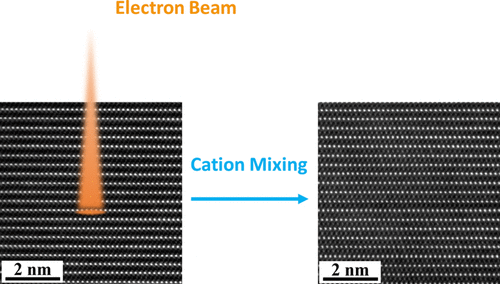当前位置:
X-MOL 学术
›
ACS Appl. Mater. Interfaces
›
论文详情
Our official English website, www.x-mol.net, welcomes your
feedback! (Note: you will need to create a separate account there.)
In Situ Observation of the Effect of Accelerating Voltage on Electron Beam Damage of Layered Cathode Materials for Lithium-Ion Batteries
ACS Applied Materials & Interfaces ( IF 8.3 ) Pub Date : 2019-11-14 , DOI: 10.1021/acsami.9b15608 Jae-Hyun Shim 1 , Hyosik Kang 2 , Young-Min Kim 3 , Sanghun Lee 2
ACS Applied Materials & Interfaces ( IF 8.3 ) Pub Date : 2019-11-14 , DOI: 10.1021/acsami.9b15608 Jae-Hyun Shim 1 , Hyosik Kang 2 , Young-Min Kim 3 , Sanghun Lee 2
Affiliation

|
Electron beam damage from transmission electron microscopy of layered lithium transition-metal oxides is a threshold phenomenon that depends on the electron beam energy, which we demonstrate in this study by varying the accelerating voltage of a scanning transmission electron microscope. The electron beam irradiation experiment shows that Ni in LiNiO2 has much lower threshold energy for displacement than Co in LiCoO2, which is supported by DFT calculations predicting that Ni has lower migration energy. The transition-metal ions are reduced from the oxidation state of +3 to +2 during migration from their original positions to the lithium sites, and Ni is more easily reduced than Co because of its electronic configuration. In addition, the high-energy electron beam induces oxygen release, which is another symptom of degradation of materials that occurs more strongly in Ni-containing materials with ion displacement.
中文翻译:

加速电压对锂离子电池层状正极材料电子束损伤影响的原位观察
层状锂过渡金属氧化物的透射电子显微镜造成的电子束损伤是取决于电子束能量的阈值现象,我们在本研究中通过改变扫描透射电子显微镜的加速电压来证明这一点。电子束辐照实验表明,LiNiO 2中的Ni的位移阈值能量比LiCoO 2中的Co低得多。,这得到了DFT计算的支持,该计算预测了Ni具有较低的迁移能。过渡金属离子在从其原始位置迁移到锂位置的过程中,从+3的氧化态还原为+2,并且由于其电子结构,与Co相比,Ni更容易还原。另外,高能电子束引起氧释放,这是材料降解的另一种症状,其在具有离子置换的含镍材料中更强烈地发生。
更新日期:2019-11-14
中文翻译:

加速电压对锂离子电池层状正极材料电子束损伤影响的原位观察
层状锂过渡金属氧化物的透射电子显微镜造成的电子束损伤是取决于电子束能量的阈值现象,我们在本研究中通过改变扫描透射电子显微镜的加速电压来证明这一点。电子束辐照实验表明,LiNiO 2中的Ni的位移阈值能量比LiCoO 2中的Co低得多。,这得到了DFT计算的支持,该计算预测了Ni具有较低的迁移能。过渡金属离子在从其原始位置迁移到锂位置的过程中,从+3的氧化态还原为+2,并且由于其电子结构,与Co相比,Ni更容易还原。另外,高能电子束引起氧释放,这是材料降解的另一种症状,其在具有离子置换的含镍材料中更强烈地发生。


















































 京公网安备 11010802027423号
京公网安备 11010802027423号